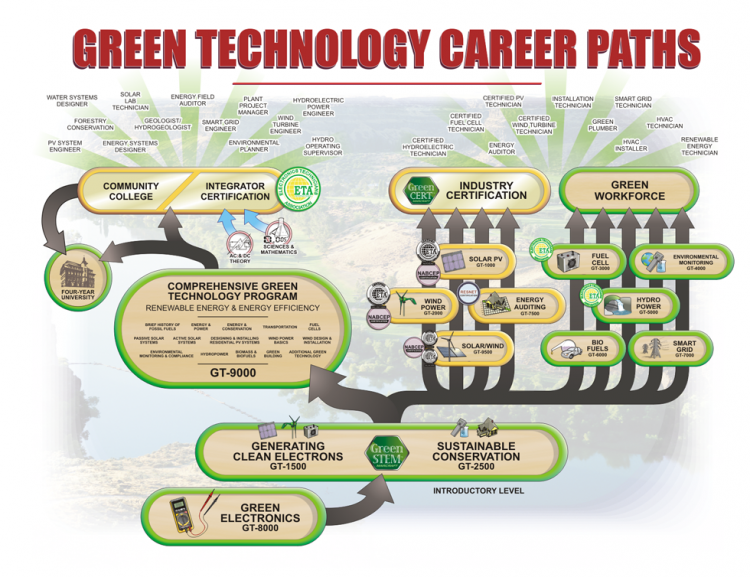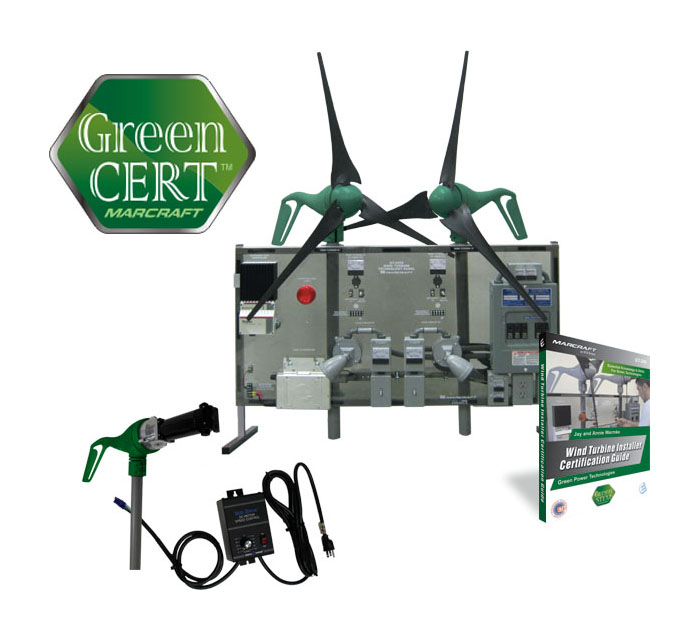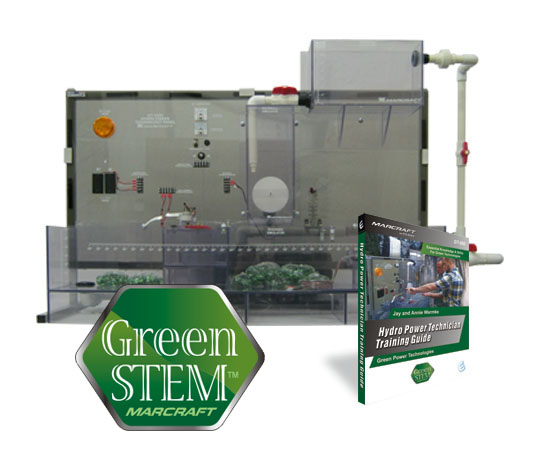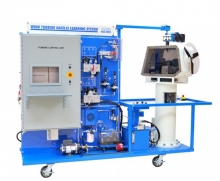Marcraft Renewable Energy & Energy Efficiency
Most of us involved in the educational field understand that Green Technology is THE NEXT BIG THING! But as with all new fields and technologies - it is very hard to define or predict. The definitions seem to change depending on who you speak with.
But however you define it, just as we all understood in the early 1980 s that computer technology would change our society in ways we could never imagine - Green Technology will shape our lives over the coming decades in profound and inevitable ways.
The new Green industry is dedicated to managing the world s natural resources and energy in a more efficient manner while allowing for an acceptable standard of living for its inhabitants. This movement, composed of many different people and organizations, has been deemed the green movement . Around the world, this movement has taken hold and is growing as it becomes apparent that key natural resources are becoming much less abundant and the demand for them is growing rapidly.
One of the key areas in the green movement is the search for cleaner, more environmentally friendly sources of electrical power. At the forefront of this search are wind power, solar power and fuel cell technologies. While these technologies are not the only source of clean energy being explored, they are the most promising technologies in the field and are generating demand for workers skilled in these areas.
Introductory ProgramsAdvanced ProgramsComprehensive ProgramsIntroductory Programs
The Marcraft GreenSTEM™ program incorporates and reinforces key Science, Technology, Engineering and Math (STEM) concepts and principles.
Provides the basics of green techology, including wind turbines photovoltaic cells, fuel cells, sustainable conservation and electronics.
Generating Clean Electrons
The GT-1500 Clean Electron Generation Panel provides students an introductory hands-on interactive experience with the three leading sources of alternative energy generation technologies.
Wind Power
- Installing and testing a wind turbine.
- Configuring and testing off-grid installations.
- Design/create a wind turbine power system.
Solar Power
- Installing, combining and testing solar panels.
- Configuring, testing and operating off-grid solar installations.
- Design/create a solar charging system for portable hand-held devices.
Sustainable Conservation
The GT-2500 Sustainable Conservation Technology Panel provides students an introductory hands-on interactive experience with multiple energy design, monitorying and auditing processes and technologies.
Green Electronics
The GT-8000 Green Electronics Technology Panel provides students an introductory hands-on interactive experience with multiple energy generating and electronic component technologies
Advanced Programs
Each program focuses on one of eight different green technologies. Train for career or industry certification.
In the Marcraft RE & EE Program, students also have the option to prepare for individual industry-level certifications in Solar PV, Wind Power and Energy Auditing, as well one of the Alternative Energy Integrator Exams.
Using current industry theory and hands-on practices, the Marcraft RE & EE Program includes:
- Hands-on training panels for 7 individual technologies, which includes Solar PV, Wind Power, Fuel Cells, Environmental Monitoring, Hydro Power, Biofuels, Smart Grid and Energy Auditing.
- Fully illustrated student text written by green industry luminary Jay Warmke.
- Fully illustrated lab guide featuring guided hands-on procedures as well as open research and design activities.
Programs / Certifications
Solar Photovoltaic Installer Certification
Prepare students for ETA Certification and portions of the NABCEP Certification test.
Alternative Energy Generation
- History of fossil fuels
- Environmental concerns
- Price convergence
Energy and Power
- Types of energy
- Potential and kinetic energy
- Voltage and corrent
- Electrical loads
Passive Solar Systems
- Angular and reflective light
- Passive solar heating
- Passive solar cooling and shading
- Convective and evaporative cooling
Active Solar Systems
- Photovoltaics
- PV modules and ratings
- Inverters and metering
- Thermal heating and collection
Design & Installation of Residential Scale Photovoltaic Systems
- Mounting PV modules
- Array orientation
- Battery systems and wiring
- PV charge controllers
- Grid-tie metering
Troubleshooting PV Systems
- Locating and isolating bad panels
- Locating bad terminals, wiring and connectors
Building Codes and Compliance
- National Electrical Codes
- Underwriters Laboratories
- OSHA
- National Fire Protection Association
Understanding Blueprints
- Schematic drawings
- Working drawings
- Symbols and scaling
Wind Turbine Installer Certification
Prepare students for ETA Certification and portions of the NABCEP Certification test.
Alternative Energy Generation
- History of fossil fuels
- Environmental concerns
- Price convergence
Energy and Power
- Types of energy
- Potential and Kinetic energy
- Voltage and current
- Electrical loads
Wind Power Technology
- Global and localized wind patterns
- Windmills and electricity
- Measuring and scaling wind speed
- Calculating wind energy
- Wind farms
Wind Turbine Design
- Rotor blades and shaft design
- Pitch, flaps, yaw and furling
- Towers types and design
- Balance of design
Design & Installation of Residential Scale Wind Turbine Systems
- Site suitability
- System sizing
- Load determination
- Installation and safety
- Grid-tie metering
Troubleshooting Wind Turbine Systems
Building Codes and Compliance
- National Electrical Codes
- Underwriters Laboratories
- OSHA
- National Fire Protection Association
Understanding Blueprints
- Schematic drawings
- Working drawings
- Symbols and scaling
Available Options:
Advanced Controls (GT-2000AC)
Add mounted motors and controllers to both turbines.
Fuel Cell Technician Training
Alternative Energy Generation
- History of fossil fuels
- Environmental concerns
- Electric grid
- Alternative energy sources
Energy and Power
- Types of energy
- Potential and kinetic energy
- Voltage and current
- Electrical loads
- Electrical power consumption
- Power math
- Making electrical connections
Fuel Cells
- History of fuel cells
- Hydrogen production, storage and transportation
- Types of fuel cells
- How fuel cells work
- Fuel cell systems
- Future of fuel cells
Building Codes and Compliance
- National Electrical Codes
- Underwriters Laboratories
- OSHA
- National Fire Protection Association
Environmental Monitoring Training
Measuring the Environment
- Monitoring air quality
- Radon gas
- Carbon monoxide and combustible gases
- Carbon dioxide
- Volatile organic compounds
- Airborne lead
- Asbestos
- Monitoring water quality
- Radon in water
- Heavy metals
- Pesticides
- Environmental pH water assessments
- Sound and noise pollution
- Light and UV radiation
- Environmental pH soil sampling
- Lead pollution in soil
Building Codes and Compliance
- National Electrical Codes
- International building codes
- Underwriters Laboratories
- EPA
- OSHA
- National Fire Protection Association
Hydro Power Technician Training
Alternative Energy Generation
- History of fossil fuels
- Environmental concerns
- Electric grid
- Alternative energy sources
Energy and Power
- Types of energy
- Potential and Kinetic energy
- Voltage and current
- Electrical loads
- Electrical power consumption
- Power math
- Making electrical connections
Hydro Power
- History of hydro power
- Hydro power terms
- Measuring head and flow
- Microhydro power systems
- Turbines
- Maintenance
- Economics of microhydro power
Building Codes and Compliance
- National Electrical Codes
- International building codes
- Underwriters Laboratories
- EPA
- OSHA
- National Fire Protection Association
Biofuels Technician Training
Alternative Energy Generation
- History of fossil fuels
- Environmental concerns
- Electric grid
- Alternative energy sources
Energy and Power
- Types of energy
- Potential and Kinetic energy
- Power math
- Transportation fuels
Biomass and Biofuels
- Biomass and biofuels basics
- Types of energy produced
- Pyrolysis
- Gasification
- Anaerobic Digestion
- Ethanol, Biodiesel & green diesel
- Limitations to overcome
Small Scale Bioenergy Production
- Wood gas generators
- Backyard ethanol
- Backyard Biodiesel
- Safety and quality control
- By-product management
Smart Grid Technician Training
Energy and Power
- Types of energy
- Potential and kinetic energy
- Voltage and current
- Electrical loads
- Electrical power consumption
- Power math
- Making electrical connections
Smart Grid Operations
- The power grid
- Power quality and outages
- Generation and storage options
- Distributed power equipment/cogeneration
- Energy distribution vs. bulk storage
- Demand response & power storage management
Functions of a Smart Grid
- Smart grid communications
- Meter management systems
- Smart meters
- Residential, municipal and commercial grids
- Support for demand & automated adjustments
- Smart grid development
- Research and regulation
- Dealing with renewable energy
Building Codes and Compliance
- National Electrical Codes
- Underwriters Laboratories
- EPA
- OSHA
- National Fire Protection Association
Understanding Blueprints
- Schematic drawings
- Working drawings
- Symbols and scaling
Energy Auditing Certification
Prepare students for portions of the RESNET Certification!
Sustainable Architecture
- What is green?
- History of fossil fuels
- Sustainable architecture
Residential and Commercial Structures
- Foundations, walls, roofs and attics
Energy and Power
- Types of energy
- Potential and kinetic energy
- Voltage and current
- Electrical loads
- Electrical power consumption
- Power math
- Making electrical connections
Energy and Conservation
- Energy Audits
- Insulation, windows and ventilation
- Lighting
- Hot water heaters
Passive Solar Systems
- Lighting, heating and cooling
Green Building
- Resource-conscious design concepts
- Sustainable construction terminology
- Green building certification
- LEED
- Green design considerations
Building Codes and Compliance
- National Electrical Codes
- EPA
- OSHA
- National Fire Protection Association
Understanding Blueprints
- Schematic drawings
- Working drawings
- Symbols and scaling
Solar PV & Wind Turbine Certification
Alternative Energy Generation
- History of fossil fuels
- Environmental concerns & price convergence
Energy and Power
- Types of energy
- Electrical loads
Passive Solar Systems
- Angular and reflective light
- Passive solar heating, cooling and shading
- Convective and evaporative cooling
Active Solar Systems
- Photovoltaic modules and ratings
- Inverters and metering
- Thermal heating and collection
Design & Installation of Residential Scale Photovoltaic Systems
- Mounting & orientating PV modules
- Battery systems and wiring
- PV charge controllers
- Grid-tie metering
Troubleshooting PV Systems
- Locating and isolating bad panels
- Locating bad terminals, wiring and connectors
Wind Power Technology
- Global and localized wind patterns
- Windmills and electricity
- Measuring and scaling wind speed
- Wind farms
Wind Turbine Design
- Rotor blades and shaft design
- Pitch, flaps, yaw and furling
- Towers types and design
Design & Installation of Residential Scale Wind Turbine Systems
- Site suitability & system sizing
- Load determination
- Installation and safety
- Grid-tie metering
Troubleshooting Wind Turbine Systems
- Locating bad terminals, wiring and connectors
- DC storage control
Building Codes and Compliance
- National Electrical Codes
- Underwriters Laboratories
- OSHA
- National Fire Protection Association
Understanding Blueprints
- Schematic drawings
- Working drawings
- Symbols and scaling
Comprehensive Programs
Combines each of the individual technologies explored in the advanced programs.
The GT-900 Green Technology Textbook
The new Green industry is dedicated to managing the world s natural resources and energy in a more efficient manner while allowing for an acceptable standard of living for its inhabitants. This movement, composed of many different people and organizations, has been deemed the green movement . Around the world, this movement has taken hold and is growing as it becomes apparent that key natural resources are becoming much less abundant and the demand for them is growing rapidly.
One of the key areas in the green movement is the search for cleaner, more environmentally friendly sources of electrical power. At the forefront of this search are wind power, solar power and fuel cell technologies. While these technologies are not the only source of clean energy being explored, they are the most promising technologies in the field and are generating demand for workers skilled in these areas.
Features key concepts and practical application guidelines for:
- Solar (Photovoltaic) Power (design and installation)
- Solar Thermal (solar hot water)
- Small Wind Power (design and installation)
- Fuel Cell technology
- Biofuels (ethanol and biodiesel) and Biomass
- Micro Hydro Power systems
- Energy Conservation Techniques
- Energy Auditing
- Green Building Concepts
- Transportation Issues
- Environmental Compliance and Monitoring
- Ocean Energy, Geothermal Energy, Nuclear Energy and more...


















